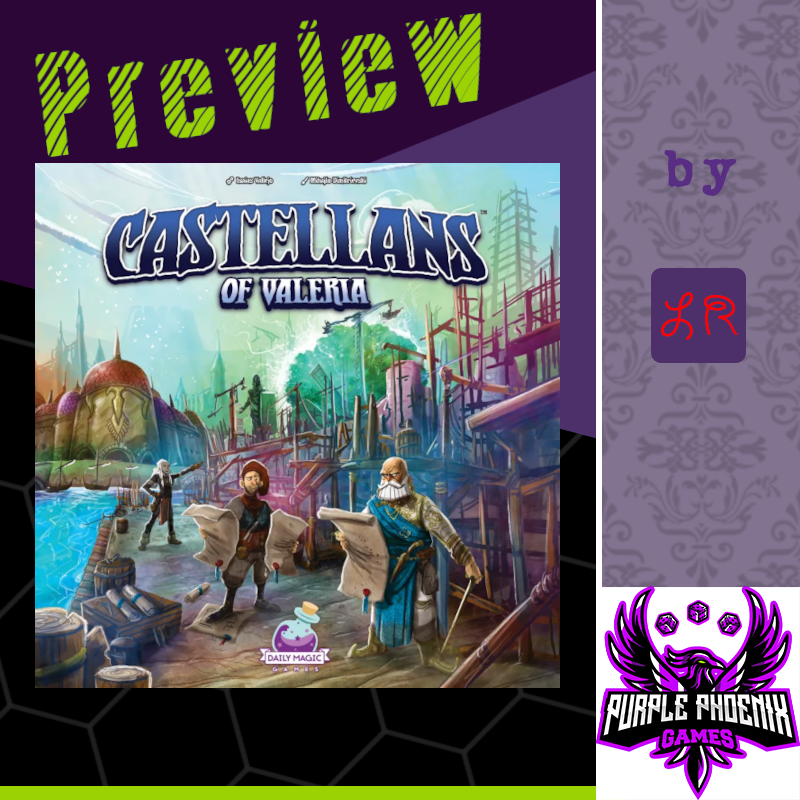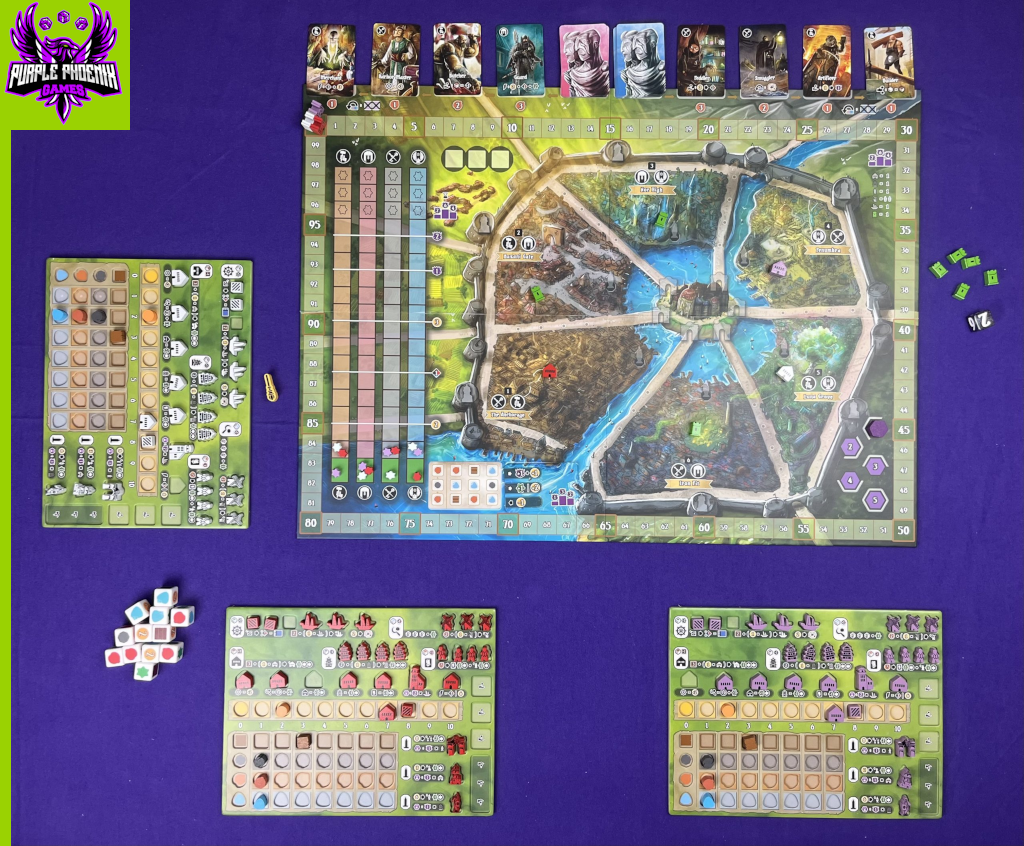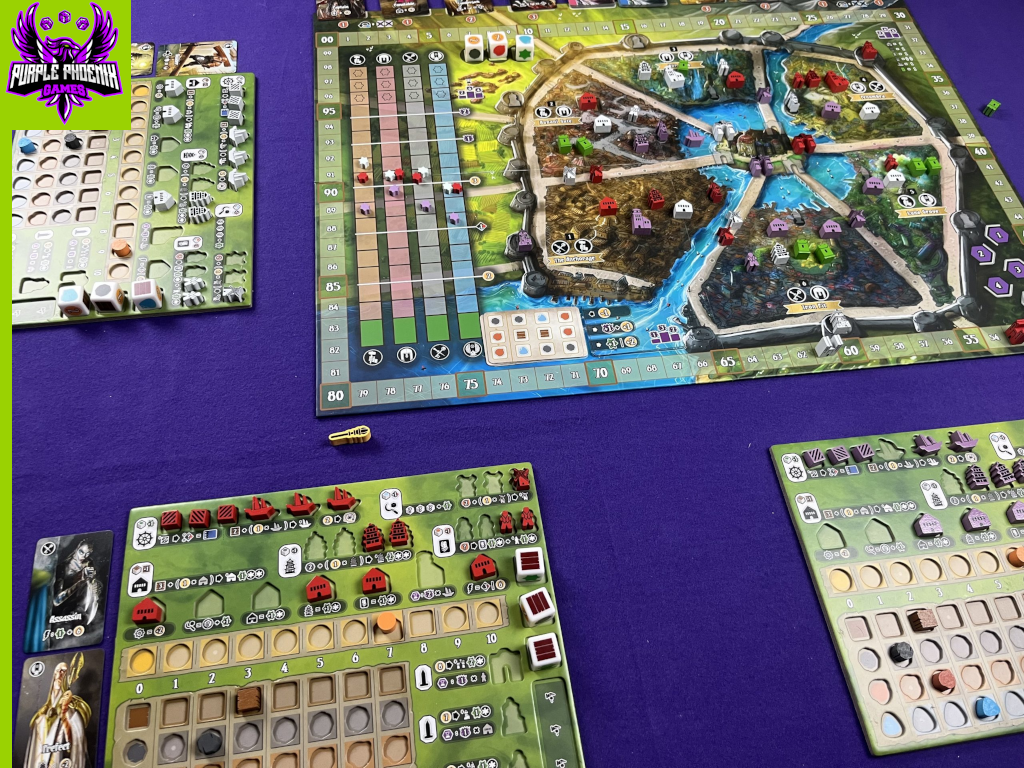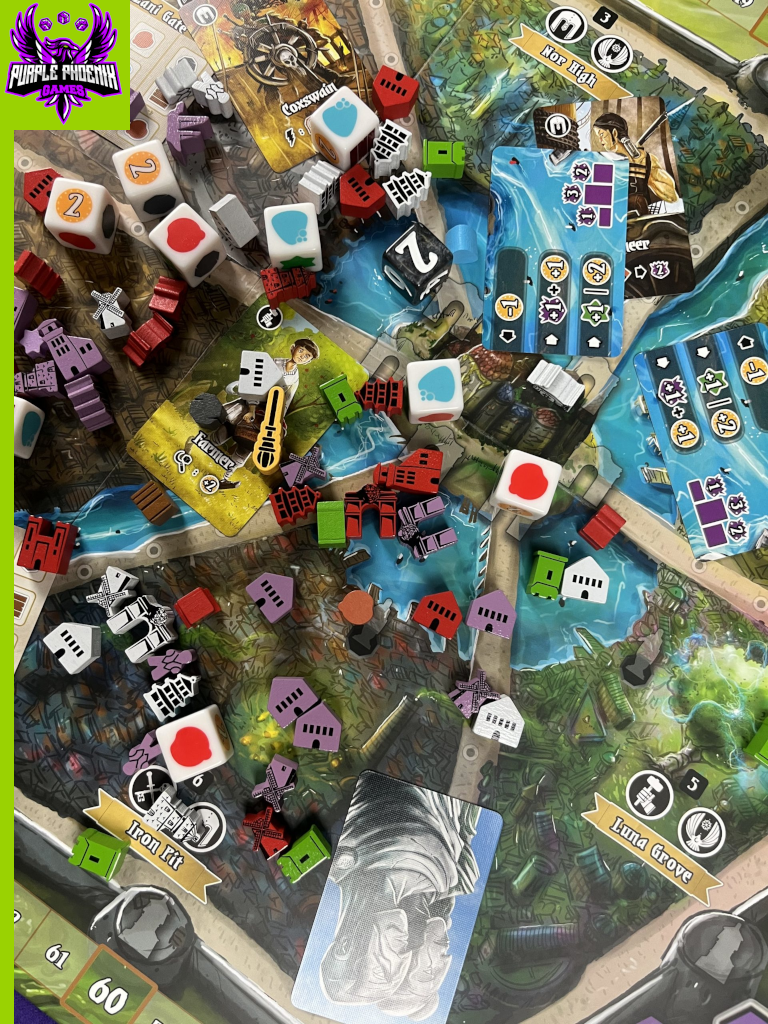
As you know, we at Purple Phoenix Games are big fans of the Valeria-verse from Daily Magic Games. So imagine how hard I fangirled when they reached out to us, asking if we would be interested in previewing their newest game in the Valeria family. Once I was able to get over the shock and awe, we got the ball rolling, and here we are. So please enjoy our preview of Castellans of Valeria!
| Castellans of Valeria (2023) | Daily Magic Games |
| 1-5 players | 60-90 minutes |
| Ages | BGG Weight – Not yet available |
Disclaimer: We were provided with a preview copy of this game for the purposes of this preview. What you see pictured below may vary from the finalized production versions of the game. I also do not intend to rehash the entire rulebook, but rather give a general overview of the rules and gameplay. If you are interested in the finer details, check out the rulebook on the Kickstarter page! -L
Castellans of Valeria is a game of dice drafting, resource management, and city building in which players are tasked with developing and running the city of Kosk. As the Castellan, your aim is to outperform the other Castellans (amass the most VP) and earn the favor of the Duke! To setup for a game, set the main board in the center of the table. Shuffle the two Citizen decks and place them in their respective spaces, creating a Market for each. Score Tokens are placed on the start of the VP track, and Influence Tokens are placed at the bottom of the 4 Guild Tracks. Shuffle the Wharf cards and place them accordingly. Players set out a starting Manor Token in one of the six Districts on the Main Board, and adjust their Influence Tokens are placed on the Guild Tracks. Each player then receives a Player Board and tokens (Cargo, Ships, Windmills, Manors, Temples, Citizens, Gates, Statues, and Ward Towers) in their chosen color, along with starting resources of Gold, Wood, Stone, Food, and Magic. Choose a 1st player, give them all the dice for the pool, and the game is ready to begin! I didn’t detail every single rule for setup, so be sure to check the rulebook, but those are the main elements. Pictured below is the setup for a 3-player game.

The game is played over 5 rounds, and each round is broken down into 4 phases: Draft, Action, Score, and Reset. To start a round, the 1st player will take all the dice and roll them to create the dice pool. Once the pool has been set, each player takes turns drafting dice to their Player Board. When you draft a die, put it on your Player Board and gain the listed Resource. The next clockwise player then drafts a die, and this phase continues until there all players have drafted 3 dice and there are 3 dice remaining in the pool. Those dice are moved to the dice spaces on the Main Board, and this phase is now over.
During the Action phase, players will take turns spending their drafted dice to perform various Actions: Ship, Harvest, Manor, Temple, or Recruit. To use the Ship action, move Cargo crates from your Player Board to the face-up Wharf card on the Main Board. This action allows you to buy or sell resources for various prices, depending on the active Wharf card. After having performed this action, you may choose to use the corresponding sub-actions, which allow you to either build a Ship in a district on the Main Board, or move a Ship to another District. Simply pay the associated resource cost and place/move your Ship. If you choose to perform the Harvest action, you will gain the resources shown on all 3 dice you drafted for this round, as well as 1 Influence on any 1 Guild Track. Since every action has an associated resource cost, Harvesting is a good way to gain those back for future purchases. After performing the Harvest action, you may choose to perform its sub-action, which allows you to build a Windmill on the Main Board.
To perform the Manor or Temple actions, pay the associated resource cost and build a Manor or Temple in a District on the Main Board. Doing so will earn you Influence on the Guild Tracks, so adjust those immediately when taking this action. Finally, to perform the Recruit action, you will pay the Market price to take an available Citizen card to your Player Board. Citizen cards provide powers for use during the game – some let you manipulate dice, others give you resources, etc. After recruiting a Citizen, take a Citizen token from your Player Board and place it in a District on the Main Board. Citizens on the board will earn you Influence on the Guild Tracks.
At any point during your turn, you may choose to perform an optional Monument action. These allow you to build a Gate, Ward Tower, or Statue in a District, and will earn you Influence on the Guild Tracks. After all players have had 3 turns in the Action phase, the game moves to the Scoring phase. Each round, a different group of districts on the Main Board will be scored. Scoring is based on control over the Districts – Manors, Temples, Ships, Citizens, and Windmills count towards a players control. Whomever has the most control (most tokens in a given District) gains 6 VP, second-most control earns 4 VP, and third earns 2 VP. In the case of a tie, players split those points as per the rules. Once each relevant District has been scored, players will score for Monuments and the Wharf. So if you’ve built any of your Monuments, you could score additional VP every round. The Wharf is scored like the districts, so whomever has the most control earns the most VP there.
When you are done Scoring, but you have not yet completed the fifth round, move to the Reset phase. Reset the Citizen markets, draw a new Wharf card, and gather up all the dice. The 1st player rotates to the left, and a new round is ready to begin. If you are done with Scoring and you have completed five rounds of play, you will perform the Final Scoring. Players will earn extra VP based on their standings on each of the four Guild Tracks. Tally up those last points, and the game ends. The player with the most VP is declared the winner!

I know that probably seems like a lot, but the basic mechanics are pretty simple – pay resources to build tokens. The ultimate strategy, however, is through the roof! There are so many options here, you will not have a dull moment throughout the entire game. First, let’s just talk action options. Every turn, you have 5 action from which to choose, and each has its own intricate workings. And some of the actions have sub-actions to expand upon the primary actions. And don’t forget the optional Monument actions as well. You must be constantly thinking turns in advance as you work to synergize your actions for maximum payoff. Resource management plays a huge role in this game, as every action has an associated cost. And as the rounds progress, paying for those actions becomes trickier. So that just adds one more thing on your plate when it comes to adapting overall strategy.
Another unique element that influences your strategic choices is the Scoring phase. Every round, a different set of Districts will be scored. So do you use your round to load up the Districts for this round? Or do you spend a precious turn setting yourself up for a future round? By the end of the game, each District will have been scored a total of 3 times, so how can you maximize your VP earnings every single Scoring phase? Earning VP is all about control – having the most tokens in a given District. But the more tokens present in a District, the higher the cost to build additional tokens of the same kind. There’s not a whole lot of direct player interaction in this game, but the battle for control is very real. How/when your opponents choose to build their tokens could greatly influence your overall strategy.
I will briefly touch on components, even though we were provided with a prototype copy of the game. That being said, it’s a very late-stage prototype, and is mostly pretty finalized. I had no issues with the components at all. They match the quality, artwork, and iconography of the other games in the Valeria-verse, and it is very well done. My one gripe would be that the rulebook did not offer any sort of key to reading the iconography. Luckily, being familiar with the other Valeria games, I was able to deduce their meanings, as they mirror many of those from the other games. Daily Magic Games has said, though, that a separate document will be included in the finalized production copies that will detail all of the icons/powers/etc. So ultimately, no worries there in the end-game production.
So how does Castellans of Valeria hold up to the other games in the Valeria-verse? It’s so great. Seriously. I think it might now be my favorite Valeria game of the bunch. Once you get the rules down, the gameplay is pretty slick. You will be constantly engaged, even when its not your turn, and you have to be quick on your feet to adjust your strategy as the Main Board changes. There are so many paths to success, and what works in one game may not necessarily work as well in the next. The replayability is very high, and I truly do not see myself getting bored with this game. As I’ve said, I’m a big fan of pretty much any Valeria game, but I would highly recommend Castellans of Valeria. You will not be disappointed. So how do you snag this game? It hits Kickstarter on June 13th. Use this link to follow, and back it when it goes live!!

